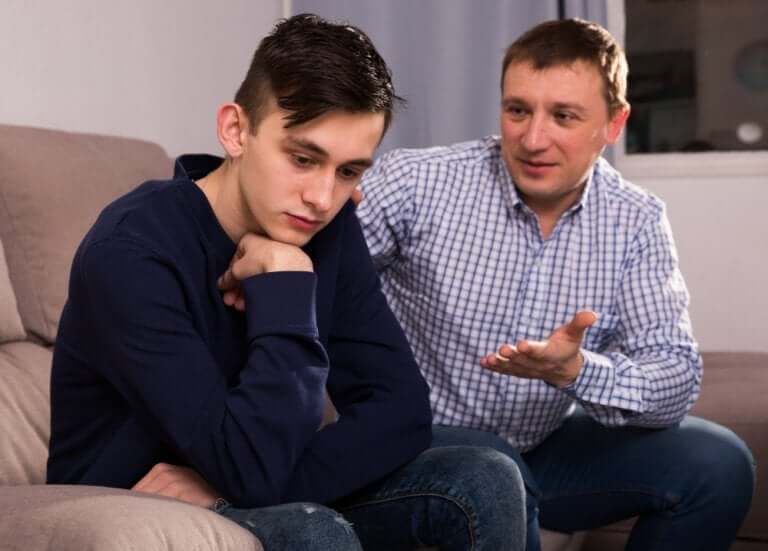Communicating with Teenagers: Mission Impossible?

According to data from the World Health Organization, adolescents (ages 10 to 19) represent approximately one-sixth of the world’s population (1.2 billion people). They all have their very specific needs, and communicating with teenagers is becoming more and more important.
Most young people are in good health, but premature mortality and injuries among adolescents remain considerable. Developing innovative strategies that address the issue of communication with adolescents is an essential task.
Communicating with teenagers
Communicating with teenagers can be a task that seems beyond us sometimes, and is a great challenge. However, it can also be very satisfying.
Promoting healthy behavior during adolescence and adopting measures to better protect young people against health risks is essential for the prevention of future health problems in adulthood.
It’s also so for the future health of different countries and for their ability to develop and prosper. Adolescence is one of the fastest phases of human development, according to research data from the World Health Organization.
Biological maturity precedes psychosocial maturity. This has implications for the solutions that health policies offer during adolescence
–World Health Organization–

Younger teenagers can be particularly vulnerable when their abilities are still developing and their lives are beginning to extend beyond the limits of their families. The different physical and emotional changes in adolescence have health consequences not only at this stage of their lives, but also for adulthood.
Some advances and new challenges
Despite advances in adolescent health, there are still many challenges that require the implementation of a series of innovative proposals in order to achieve satisfactory results. Communicating with teenagers is a vital tool that shouldn’t be overlooked.
What do we know?
On the one hand, communication doesn’t grow on trees and it has a certain trajectory it needs to take. It also has patterns you need to follow and review. On the other hand, communication with teenagers isn’t just any old relationship, but one that involves our affections and emotions.
Some teenage characteristics
When trying to communicate better, it’s very important not to lose sight of the fact that these teenagers are our children, nephews, grandchildren, and godchildren. They are, therefore, relationships that come loaded with feelings.
Adolescence is, at the same time, a stage of life in which there is concern for the here and now, but also for the near and long-term future. You must have a healthy firmness in your day-to-day contact, as well as consistency when setting limits, in order to cope with the particular challenges that adolescence throws up.
It’s a time when there’s an increased desire to explore, experience, search, desire, and make decisions.

Factors that favor good communication with teenagers
- Use appropriate words and gestures
- Defend your own views without anger or arguments
- Take into account your teenager’s ideas and interests
- Find reasonable compromises and solutions for both parties
It’s essential to not only know the art of listening, but also to put it into practice.
Signs that show whether you’re listening to your teenager or not
- Pay full attention to them when they’re speaking. Show them that you’re listening by looking at them in the eye frequently. You can also use gestures and verbal expressions.
- Repeat the key points of what they’re telling you – things that, for them, are very important. Let them know that you understand where they’re coming from.
- Don’t interrupt, except to show that you’re listening or to ask for clarification if you don’t understand something.
If you’ve met some of these conditions, then you may indeed be listening well and paying attention to what they’re telling you – two essential starting points for good communication, and even more so in the adolescence years.
According to data from the World Health Organization, adolescents (ages 10 to 19) represent approximately one-sixth of the world’s population (1.2 billion people). They all have their very specific needs, and communicating with teenagers is becoming more and more important.
Most young people are in good health, but premature mortality and injuries among adolescents remain considerable. Developing innovative strategies that address the issue of communication with adolescents is an essential task.
Communicating with teenagers
Communicating with teenagers can be a task that seems beyond us sometimes, and is a great challenge. However, it can also be very satisfying.
Promoting healthy behavior during adolescence and adopting measures to better protect young people against health risks is essential for the prevention of future health problems in adulthood.
It’s also so for the future health of different countries and for their ability to develop and prosper. Adolescence is one of the fastest phases of human development, according to research data from the World Health Organization.
Biological maturity precedes psychosocial maturity. This has implications for the solutions that health policies offer during adolescence
–World Health Organization–

Younger teenagers can be particularly vulnerable when their abilities are still developing and their lives are beginning to extend beyond the limits of their families. The different physical and emotional changes in adolescence have health consequences not only at this stage of their lives, but also for adulthood.
Some advances and new challenges
Despite advances in adolescent health, there are still many challenges that require the implementation of a series of innovative proposals in order to achieve satisfactory results. Communicating with teenagers is a vital tool that shouldn’t be overlooked.
What do we know?
On the one hand, communication doesn’t grow on trees and it has a certain trajectory it needs to take. It also has patterns you need to follow and review. On the other hand, communication with teenagers isn’t just any old relationship, but one that involves our affections and emotions.
Some teenage characteristics
When trying to communicate better, it’s very important not to lose sight of the fact that these teenagers are our children, nephews, grandchildren, and godchildren. They are, therefore, relationships that come loaded with feelings.
Adolescence is, at the same time, a stage of life in which there is concern for the here and now, but also for the near and long-term future. You must have a healthy firmness in your day-to-day contact, as well as consistency when setting limits, in order to cope with the particular challenges that adolescence throws up.
It’s a time when there’s an increased desire to explore, experience, search, desire, and make decisions.

Factors that favor good communication with teenagers
- Use appropriate words and gestures
- Defend your own views without anger or arguments
- Take into account your teenager’s ideas and interests
- Find reasonable compromises and solutions for both parties
It’s essential to not only know the art of listening, but also to put it into practice.
Signs that show whether you’re listening to your teenager or not
- Pay full attention to them when they’re speaking. Show them that you’re listening by looking at them in the eye frequently. You can also use gestures and verbal expressions.
- Repeat the key points of what they’re telling you – things that, for them, are very important. Let them know that you understand where they’re coming from.
- Don’t interrupt, except to show that you’re listening or to ask for clarification if you don’t understand something.
If you’ve met some of these conditions, then you may indeed be listening well and paying attention to what they’re telling you – two essential starting points for good communication, and even more so in the adolescence years.
All cited sources were thoroughly reviewed by our team to ensure their quality, reliability, currency, and validity. The bibliography of this article was considered reliable and of academic or scientific accuracy.
- Organización Mundial de la Salud. (2014).
- Luis Feduchi Benlliure. (2011). “El adolescente ante su futuro” Temas de Psicoanálisis, 2011.
This text is provided for informational purposes only and does not replace consultation with a professional. If in doubt, consult your specialist.








